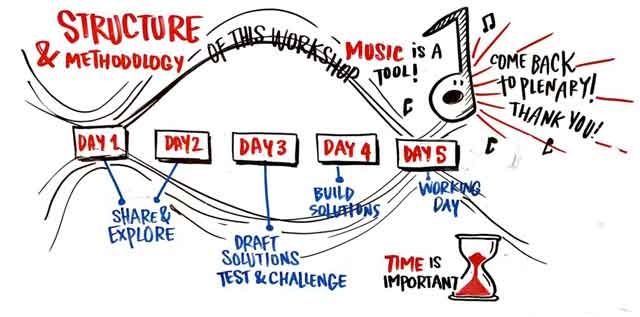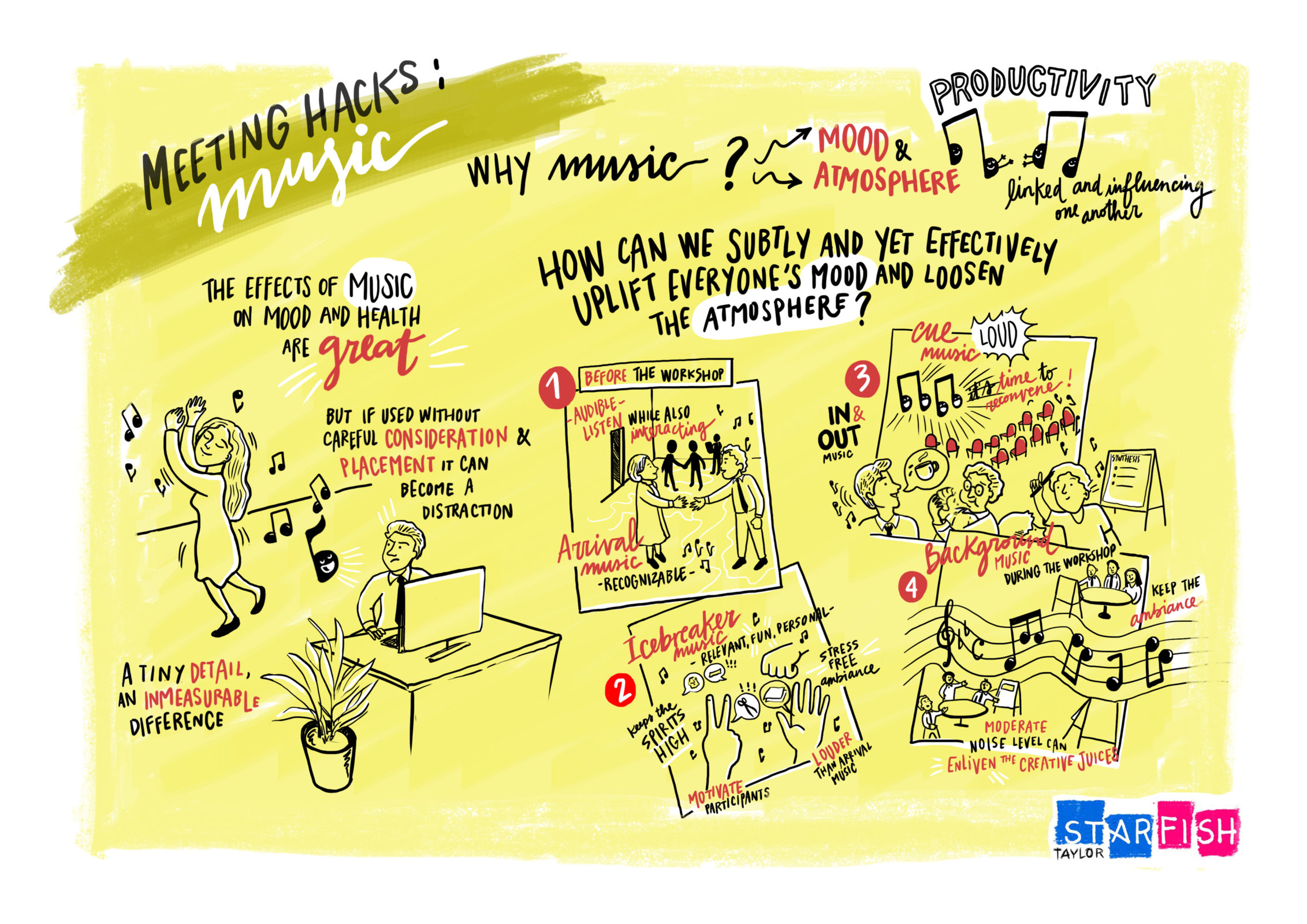Life is a song, a dance, every day a new orchestration, full of new harmonies and rhythms and beats and melodies. Music makes life’s fluctuations less painful, and the mundane routines more manageable. Wouldn’t you agree? So what about music in the workplace? Or, dare I say, integrated into a workshop or meeting??
Music as a Tool
Numerous studies have been conducted about the effect of music on mood and health, and it’s safe to say the effects are mostly good, if not great. At Starfish Taylor, we totally agree. When it comes to music in the workplace, however, it becomes a question of how music affects one’s productivity. If used without careful consideration and placement, there’s no doubt it can become a distraction and nuisance. But we’re here to show you how music, if integrated appropriately and methodically, is an asset and one of the simplest ways to boost (and not bust) your next workshop or meeting. We believe it’s a tiny detail that can make an immeasurable difference.
Music produces a kind of pleasure which human nature cannot do without. – Confucius
Why Music?
There are two key words to remember here: mood and atmosphere.
Work ethic and productivity have everything to do with one’s mood. The better it is, usually the better the output. And the same goes for atmosphere. Think of these elements as two halves of the same whole, interchangeably linked and influencing one another. In terms of a workshop or meeting, these factors aren’t something we can completely control. But our goal is not to control, but rather, to enhance, improve, and boost. And that’s exactly what we do. We ask ourselves, “How can we subtly and yet effectively uplift everyone’s mood and loosen the atmosphere?” It comes down to integrating the music into specific stages of the workshop, for different purposes. And depending on the purpose or stage, choosing the appropriate type of music to use. It’s also important to know when music is not appropriate to play.

Music and silence combine strongly because music is done with silence, and silence is full of music. – Marcel Marceau
The Different Stages of Integrating Music
Before the workshop or meeting begins:
We select some slightly upbeat, recognizable music – think Moby, AIR, Compay Segundo, Zero 7 – to set the scene and welcome participants in to the room. We call this the “Arrival Music” (SFT: Arrival). Volume is kept at an audible, yet reasonably low level, allowing participants to listen while also interacting with the others coming in. Once everyone has arrived, we slowly turn the music off and have everyone gather in front so that the facilitator and sponsor can give everyone the verbal welcome, introduction and workshop briefing.
Icebreaker music:
Now that the participants are in and ready for the day, it’s important to keep the twin elements (mood and atmosphere) positive and loose. That’s why we kickoff every session with a quick icebreaker. We make sure they’re not only relevant, but also fun and personal, which keeps spirits high and the overall ambiance loose and stress-free. Check out our list of proven icebreakers here.
“Icebreaker Music” can be played louder than the Arrival Music as its purpose is to get people moving; motivate participants and get their creative wheels spinning. It’s the first use of Cue music.
Cue music:
The purpose of this kind of music is exactly as it sounds: to signal participants it’s time to reconvene as a whole or disband into groups. We create playlists to “SFT: Send them out” to modules as well as to “SFT: Bring them in” to plenary. These snippets of sound are meant to be loud, which essentially trains participants to stop what they’re doing as soon as they here the cue or “In & Out Music”.
Background music during the workshop or meeting:
What better kind of music to keep the ambiance of a workshop than Ambient music? It may not be your favorite genre, but studies have suggested that moderate noise levels can enliven the creative juices – if used within reason, of course. During certain modules, we put on “Ground Music” to work to such as when in Individual Point of View. (Check out our playlist, SFT: Work.) When we do play this, however, we play it on low volume levels, as often, we do not play any music. The “music”, instead, comes from people in deep discussion, which is the best music of all.
Modules:
Spotify – SFT – Marshmallow Challenge Playlist
Playlists for some specific modules like, The Marshmallow Challenge, can be more upbeat as its purpose correlates more with that of an icebreaker: boosting participants’ motivation and team rapport. This challenge lasts 18 minutes, so we’ve created playlists that really follow the challenge’s intensity by choosing songs that motivate participants as well as signal that time is ticking, or the end is coming soon!
Contact Us
We’d love to help. Reach out here.
Category: Blog Post, Meeting Hacks
Tags: Meeting Hacks, Music
Subscribe to Blog Updates
Recent Posts
- Sustainability in the O&G industry
- Build a new Customer Experience
- How to frame, develop, and implement a strategy – the Bookend Workshop Model
- 3 Simple Tips to Improve Experience at Employee Engagement Workshops
- Facilitator Brad Allen
- Why Your Last Meeting Probably Sucked (and How to Fix It in 3 Steps)
- Employee Engagement Quick Wins Part-2
- Employee Engagement Quick Wins Part-1
- Employee Engagement Management Perspective
- Taking The Employee Perspective On Engagement
- How to kick off a great Employee Engagement workshop
- How to improve employee engagement in less time for less budget
- Graphic Facilitator: Didier Gallon
- Meeting Hack: Meeting Room Essentials
- Meeting Hack: How to Avoid Workshop Pitfalls
- Graphic Facilitator: Stephanie Corne
- Graphic Facilitator: Fernanda de Uriarte
- Graphic Facilitator: Tikka Hun
- Meeting Hack: Using Music as a Tool
- Graphic Facilitator: Lance Bell
- Scenarios For Digital Economy
- Current State and Future State
- Deployment Plan for Global Transformation
- SPE Vision for Digital Energy Conference
- LEAN for a Legal Department
- Health Safety Environment Roadmap
- The Future of Communication
- Free Prize Inside Icebreaker: Focused Performance Improvement
- Rock Paper Scissors Icebreaker: Energizing the Masses
- Yellow Pages Icebreaker: Mergers & Acquisitions
- Into the Matrix Icebreaker
- What is Scrum?
- Team Building Icebreaker: Finding Three Things in Common
- Top Three Icebreaker: Guessing the Priorities
- 6 Keys to a Great Workshop
- Family Vacation Icebreaker: Compromising Customer Needs, Creating the Ideal
- Secret Service Icebreaker: Cracking Your Code Name Alter Ego
- WORKSHOPS | MEETINGS
- Behind The Name of Starfish Taylor
- Supermarket Icebreaker: Blending Products with Personalities
- Throw Away Your Old Agenda!
- Death by Powerpoint
- Our Mission to end the World of Bad Meetings
- Big Data Icebreaker
- Meeting Hacks: Icebreakers
- Innovation Workshops – Five Ted Talks We Like
- Welcome to our Blog



